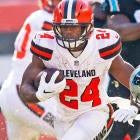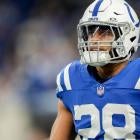Jump to ...
As a position group, running backs matter. They've always mattered. They're huge components of Fantasy in that they're highly productive thanks to their workloads, they're the best trade currency out there and there are enough good ones to go around.
That means Fantasy owners have plenty of strategies when it comes to drafting them, and your league's scoring system will play a huge role in what strategy you go with.
Once you know your lineup requirements and scoring system, you can answer these questions:
- Are you willing to take risks?
- Does running back injury history matter to you?
- Do you believe in handcuffing non-elite running backs?
- Do you enjoy being active on waivers?
The first two questions are meant to help you determine how deep the running back talent pool is for you. The more chances you're willing to take and the more injuries you're willing to overlook, the more running backs you'll happily put in your starting lineup.
The second two questions are designed to get an idea of how you should attack your running back depth. There are plenty of cases where getting the real-life backup to one of your ball-carriers is wise. And if you're lazy about waivers, you might prefer to build serious running back depth on Draft Day.
Because of the bottleneck depth at receiver (limited among the elite tiers, plentiful once you get to Round 5) and the lack of "safe" running backs once you're through Round 4 or 5, You may opt to lean toward grabbing at least two reception-heavy running backs before you get to 60th overall. Expect a massive run on rushers in Round 2 and a trickle by the time you get into mid-Round 3.
But where there isn't safety, there are interesting upside picks that are pushed along by holdout running backs and rookies in good situations. It starts in Round 6 with Austin Ekeler and Miles Sanders and pushes all the way until the late rounds with Devin Singletary, Justice Hill and Alexander Mattison. I implore you to review the running backs ranked between roughly 25th and 50th at the position and find some who you'd invest in as if they were stocks. Three of my favorites:
Tony Pollard: So long as Ezekiel Elliott sits out, Pollard is assumed to be the Cowboys' back of choice. He's a good pass catcher with contact balance and burst. I like to think of him as this year's top James Conner candidate. You might want to target him if you draft Zeke.
Justin Jackson: Same as above, but in L.A. Jackson is best suited to score from short yardage and still pick up carries away from Austin Ekeler. His value shrivels when Melvin Gordon comes back, but until then he could be huge. If you draft Gordon, draft Jackson too.
Darwin Thompson: An Andy Reid running back to the core, Thompson is a speedy short scatback with surprising power. He's also a good pass blocker, which could earn him some playing time sooner than later. Draft him and be patient.
Is Zero RB still a thing?
It is! And, it's not a bad way to go if you're picking late in Round 1/early in Round 2 in full PPR or are in a smaller league (10 or fewer teams). You could kick off a team with DeAndre Hopkins, Travis Kelce and Julian Edelman and still find Tier 3 running backs later on. This plan is a lot less appealing in non-PPR due to receptions becoming meaningless, and it's straight-up insanity to do it when there's an elite-tier running back staring you in the face, so rule it out if you have an early first-round pick.
The other key is to select unpopular backs who will at least start the season in a prominent role (maybe Jordan Howard, maybe Peyton Barber). You'll squeeze points out of them before replacing them for whatever hotness comes to you off waivers. You must be willing to be active in finding running backs on waivers in order to skip running backs early. If you're lazy, Zero RB is not for you.
What's the opposite of Zero RB?
I used to be all about drafting a ton of running backs, but not this year. Not with the thin crop of elite receivers and stud tight ends that will go between fourth and 24th overall. I'd rather attack those positions, though I'm not precluded from taking a running back in Round 1 or 2. I wouldn't take runners in Rounds 1 and 2 unless I found an incredible bargain (James Conner and David Johnson, or Alvin Kamara and Joe Mixon, for example).
Magic number for running backs?
I recommend drafting at least six running backs on a Fantasy roster: One or two starting-caliber guys, one or two potential starters, a couple of middle-risk, high-reward rushers who could become starters with a good start to the year and another late-round dart throw or handcuff. Five running backs could leave you too thin; eight or nine might cost you value at other positions.
Running Backs - PPR
In PPR, where wide receiver and tight end values rise with catches counting for something, you can afford to discount backs just a bit. Fantasy drafters will still chase running backs, but there's a little less pressure because there are enough of them who catch the ball and can accrue useful Fantasy points that way. I recommend going for three running backs through six rounds in PPR:
S. Barkley
PHI
Saquon Barkley
PHI
|
A. Kamara
NO
Alvin Kamara
NO
|
J. Conner
ARI
James Conner
ARI
|
E. Elliott
DAL
Ezekiel Elliott
DAL
|
N. Chubb
CLE
Nick Chubb
CLE
|
L. Bell
TB
Le'Veon Bell
TB
|
D. Johnson
NO
David Johnson
NO
|
L. Fournette
BUF
Leonard Fournette
BUF
|
C. Carson
SEA
Chris Carson
SEA
|
D. Cook
BAL
Dalvin Cook
BAL
|
K. Johnson
PHI
Kerryon Johnson
PHI
|
T. Gurley
ATL
Todd Gurley
ATL
|
D. Williams
ARI
Damien Williams
ARI
|
J. Jacobs
GB
Josh Jacobs
GB
|
D. Freeman
BAL
Devonta Freeman
BAL
|
M. Mack
ARI
Marlon Mack
ARI
|
M. Ingram
NO
Mark Ingram
NO
|
D. Montgomery
DET
David Montgomery
DET
|
T. Coleman
SF
Tevin Coleman
SF
|
A. Jones
MIN
Aaron Jones
MIN
|
S. Michel
LAR
Sony Michel
LAR
|
J. White
NE
James White
NE
|
D. Henry
BAL
Derrick Henry
BAL
|
P. Lindsay
IND
Phillip Lindsay
IND
|
M. Gordon
BAL
Melvin Gordon
BAL
|
A. Ekeler
WAS
Austin Ekeler
WAS
|
M. Sanders
CAR
Miles Sanders
CAR
|
L. Murray
BUF
Latavius Murray
BUF
|
T. Cohen
CAR
Tarik Cohen
CAR
|
K. Drake
GB
Kenyan Drake
GB
|
T. Pollard
TEN
Tony Pollard
TEN
|
J. Jackson
DET
Justin Jackson
DET
|
K. Ballage
PIT
Kalen Ballage
PIT
|
R. Penny
CAR
Rashaad Penny
CAR
|
J. Howard
NO
Jordan Howard
NO
|
D. Thompson
LV
Darwin Thompson
LV
|
D. Guice
WAS
Derrius Guice
WAS
|
P. Barber
LV
Peyton Barber
LV
|
J. Samuels
ARI
Jaylen Samuels
ARI
|
D. Harris
BUF
Damien Harris
BUF
|
D. Singletary
NYG
Devin Singletary
NYG
|
L. McCoy
TB
LeSean McCoy
TB
|
R. Jones
DAL
Ronald Jones
DAL
|
D. Lewis
NYG
Dion Lewis
NYG
|
J. Hill
BAL
Justice Hill
BAL
|
M. Breida
NYG
Matt Breida
NYG
|
R. Freeman
DAL
Royce Freeman
DAL
|
C. Thompson
CHI
Chris Thompson
CHI
|
C. Anderson
DET
C.J. Anderson
DET
|
J. Williams
NO
Jamaal Williams
NO
|
A. Peterson
SEA
Adrian Peterson
SEA
|
K. Hunt
CLE
Kareem Hunt
CLE
|
N. Hines
CLE
Nyheim Hines
CLE
|
M. Davis
BAL
Mike Davis
BAL
|
M. Brown
LAR
Malcolm Brown
LAR
|
D. Hilliard
TEN
Dontrell Hilliard
TEN
|
Running Back - Non-PPR
In non-PPR, expect most people to begin taking one running back and one wide receiver/tight end to kick off their teams. If running backs mean anything to you at all, taking three within the first five rounds -- and two in the first four -- should set you up nicely for a well-built roster:
S. Barkley
PHI
Saquon Barkley
PHI
|
A. Kamara
NO
Alvin Kamara
NO
|
J. Conner
ARI
James Conner
ARI
|
E. Elliott
DAL
Ezekiel Elliott
DAL
|
N. Chubb
CLE
Nick Chubb
CLE
|
D. Johnson
NO
David Johnson
NO
|
L. Bell
TB
Le'Veon Bell
TB
|
L. Fournette
BUF
Leonard Fournette
BUF
|
C. Carson
SEA
Chris Carson
SEA
|
D. Cook
BAL
Dalvin Cook
BAL
|
K. Johnson
PHI
Kerryon Johnson
PHI
|
T. Gurley
ATL
Todd Gurley
ATL
|
D. Williams
ARI
Damien Williams
ARI
|
J. Jacobs
GB
Josh Jacobs
GB
|
D. Freeman
BAL
Devonta Freeman
BAL
|
M. Mack
ARI
Marlon Mack
ARI
|
M. Ingram
NO
Mark Ingram
NO
|
D. Montgomery
DET
David Montgomery
DET
|
T. Coleman
SF
Tevin Coleman
SF
|
S. Michel
LAR
Sony Michel
LAR
|
D. Henry
BAL
Derrick Henry
BAL
|
A. Jones
MIN
Aaron Jones
MIN
|
P. Lindsay
IND
Phillip Lindsay
IND
|
M. Gordon
BAL
Melvin Gordon
BAL
|
A. Ekeler
WAS
Austin Ekeler
WAS
|
M. Sanders
CAR
Miles Sanders
CAR
|
J. White
NE
James White
NE
|
L. Murray
BUF
Latavius Murray
BUF
|
K. Drake
GB
Kenyan Drake
GB
|
T. Pollard
TEN
Tony Pollard
TEN
|
J. Jackson
DET
Justin Jackson
DET
|
T. Cohen
CAR
Tarik Cohen
CAR
|
K. Ballage
PIT
Kalen Ballage
PIT
|
R. Penny
CAR
Rashaad Penny
CAR
|
J. Howard
NO
Jordan Howard
NO
|
D. Guice
WAS
Derrius Guice
WAS
|
D. Thompson
LV
Darwin Thompson
LV
|
P. Barber
LV
Peyton Barber
LV
|
J. Samuels
ARI
Jaylen Samuels
ARI
|
D. Singletary
NYG
Devin Singletary
NYG
|
L. McCoy
TB
LeSean McCoy
TB
|
D. Johnson
BUF
Duke Johnson
BUF
|
D. Harris
BUF
Damien Harris
BUF
|
R. Jones
DAL
Ronald Jones
DAL
|
R. Freeman
DAL
Royce Freeman
DAL
|
J. Williams
NO
Jamaal Williams
NO
|
M. Breida
NYG
Matt Breida
NYG
|
J. Hill
BAL
Justice Hill
BAL
|
D. Lewis
NYG
Dion Lewis
NYG
|
C. Anderson
DET
C.J. Anderson
DET
|
A. Peterson
SEA
Adrian Peterson
SEA
|
K. Hunt
CLE
Kareem Hunt
CLE
|
M. Davis
BAL
Mike Davis
BAL
|
M. Brown
LAR
Malcolm Brown
LAR
|
D. Hilliard
TEN
Dontrell Hilliard
TEN
|
So what 2019 Fantasy football sleepers should you snatch in your draft? And which RB1 candidate can you wait on until late? Visit SportsLine now to get 2019 Fantasy Football cheat sheets from the model that called Matt Breida's huge season, and find out.




























